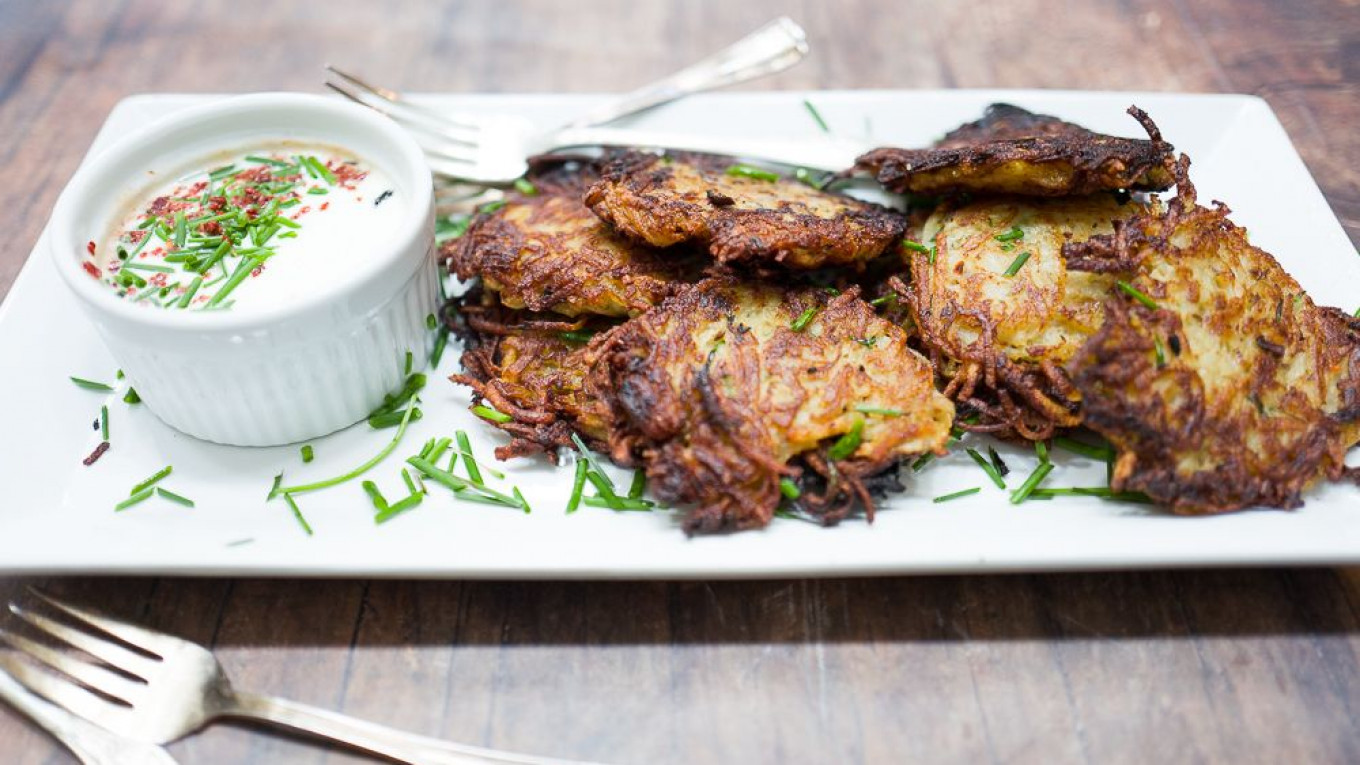Belarus is almost never in the news, let alone above the fold, but this week, Russia’s near neighbor gave the coronavirus a run for its money in front-page column inches as frustrated voters took to the streets to protest fraudulent election results. With the country’s internet blocked and very few foreign correspondents accredited, grainy footage on Twitter is the best way to follow this developing story, which could see the doyenne of European dictators returned for a sixth term as president, or the dawn of a new political era.
Call it serendipity, coincidence, or just dumb-luck timing, but this was the week I’d scheduled a long-overdue session with Belorussian cuisine.
What is Belarusian cuisine anyway?
Linguistically, culturally, and geographically Belarus and Russia are very similar, their cuisines almost indistinguishable. In both Moscow and Minsk, you will find a cuisine rooted in fermented vegetables, preserved fruits, a heavy reliance on root vegetables, fantastic breads and grains, rich dairy, and thick, stick-to-your-ribs stews, soups, and braises.
Until 2014, Belarus was not one of Europe’s stand out culinary hot spots. But after Russian imposed sanctions on meat, fish, dairy, and produce from the European Union, Belarus – a small, Central European landlocked country, best known for its waving fields of grain — overnight became the “source” for a staggering range of high-end European delicacies: “Belarusian” oysters and mussels were suddenly all the rage in Moscow, as was “Belarusian” foie gras, and delectably piquant Manchego aged to perfection in Minsk.
The mania for Belarusian lobster has not abated in Russia, but if it ever does, Belarus can always fall back on its traditional culinary superstar: draniki or potato pancakes.
What are draniki?
Most European countries east of Paris have their own version of draniki, from Swiss rösti to Polish placki ziemniaczane, German kartoffelpuffer, and not forgetting Jewish latkes. Each combines potatoes and onions and other ingredients to make a pancake, which fall roughly into two textural camps: soft and puffy versus flat and crispy. While soft and puffy draniki do very well as a side dish or perched atop a crisp salad, it is flat and crispy draniki, which truly hold their own as a standalone main course, particularly when combined with a bowl of thick sour cream.
The key challenge with draniki is how to achieve a crispy outer layer and a soft and chewy interior. Many classic draniki recipes suggest grating the potatoes by hand on the finer “star” side of a box grater, others use mashed potatoes to achieve a pillowy interior with a crispy exterior. Then the debate rages over whether to add eggs, flour, milk, and which flavorings to deploy to enhance the taste.
I test-drove several classic recipes in separate batches, which I then forced on my Russian husband for an obligatory taste test. After chewing each with due consideration, he said what he often does:
“Maybe more salt?”
This is taste tester speak for “you aren’t there yet, darling.”
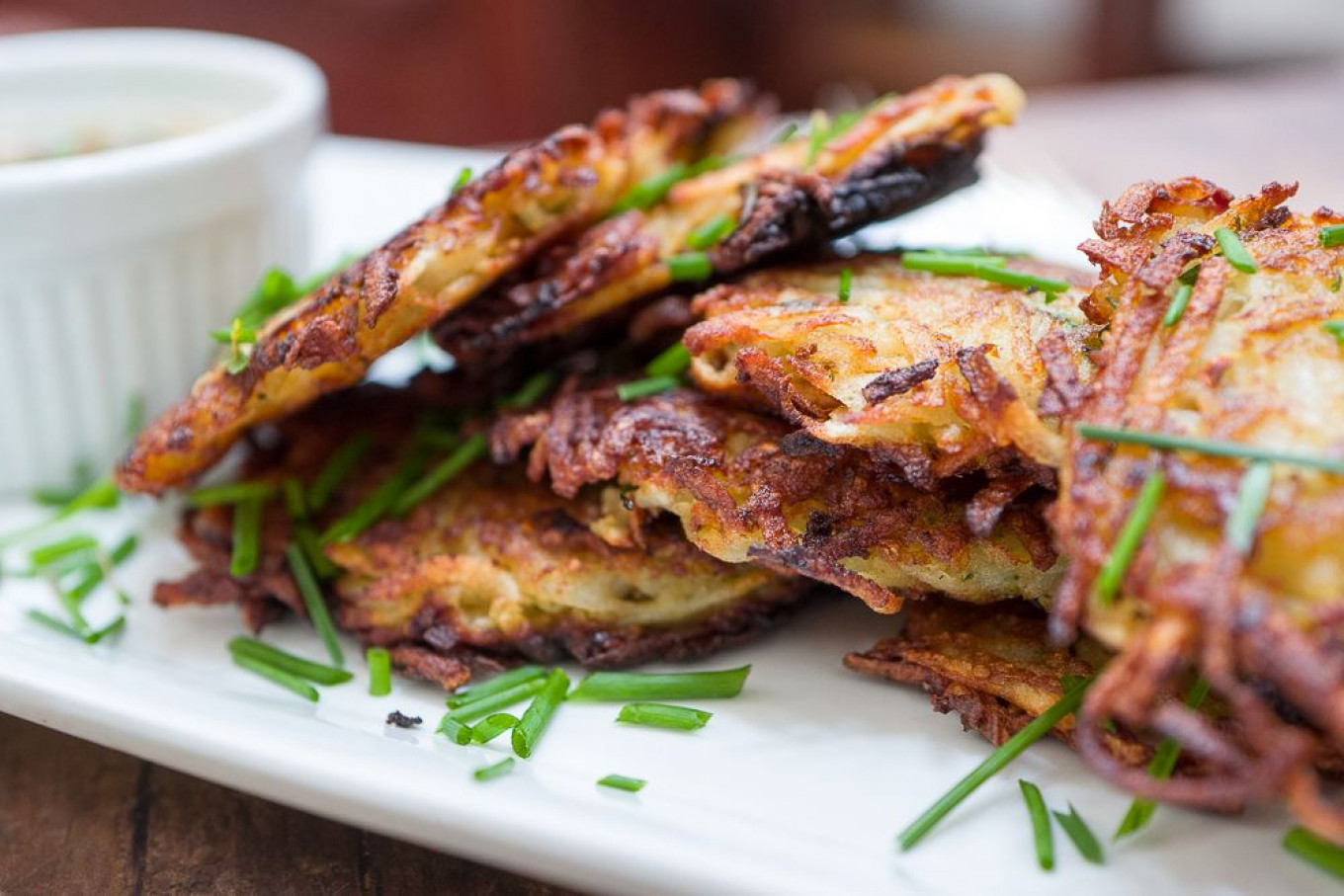
Perfecting more perfect draniki
I donned my onion goggles, renewed my efforts and grated more onions and potatoes. The result is a magnificent compromise.
I created a wet batter of grated onion, kefir, egg, and matzo flour, then folded roughly grated potatoes into it; I grated the potatoes in the food processor, and I make no apologies for this, because you need larger pieces to make this version work. This method allows the potato pieces to keep their shape and crisp up in the skillet, with a few renegade potato pieces escaping to create an especially crispy lacey halo around the edge of the pancake. The interior provides a softer, chewy contrast. Because I can never leave well enough alone, I flavored the draniki (they do need something) by adding horseradish, caraway seeds, and a little hot pepper, besides traditional salt and black pepper. I believe that draniki are the ultimate culinary blank canvas, so absolutely experiment with the many flavors, which compliment potatoes (see suggestions below).
As I file this story, the situation in Belarus remains tense and we continue to watch events with mounting concern. Forging political change is a lot harder and riskier than perfecting the perfect political pancake, though great draniki do require a very hot skillet and lots of oil, just as democracy is often forged in the heat of an August protest. In both situations, protective gear is always advisable. And perhaps I could leave the doyenne of dictators with this thought: in politics, as in cooking: if you can’t stand the heat, get out of the kitchen!
Potato Draniki
Ingredients
- 4 cups (1000 ml) shredded potatoes (4-5 Russet potatoes)
- 1 medium-sized yellow onion peeled and cored
- 4 Tbsp (60 ml) matzo flour (or 3 Tbls of All-purpose flour
- 1 egg
- 3 Tbsp of kefir or buttermilk
- 1 tsp prepared horseradish
- 1 tsp salt
- ½ tsp caraway seeds
- ¼ tsp red pepper
- Black pepper to taste
- 1 bunch chives, snipped
- Oil for frying (choose an oil with a high burn point such as Grapeseed, canola, or peanut). You will need about a cup (240 ml) or even more for this recipe.
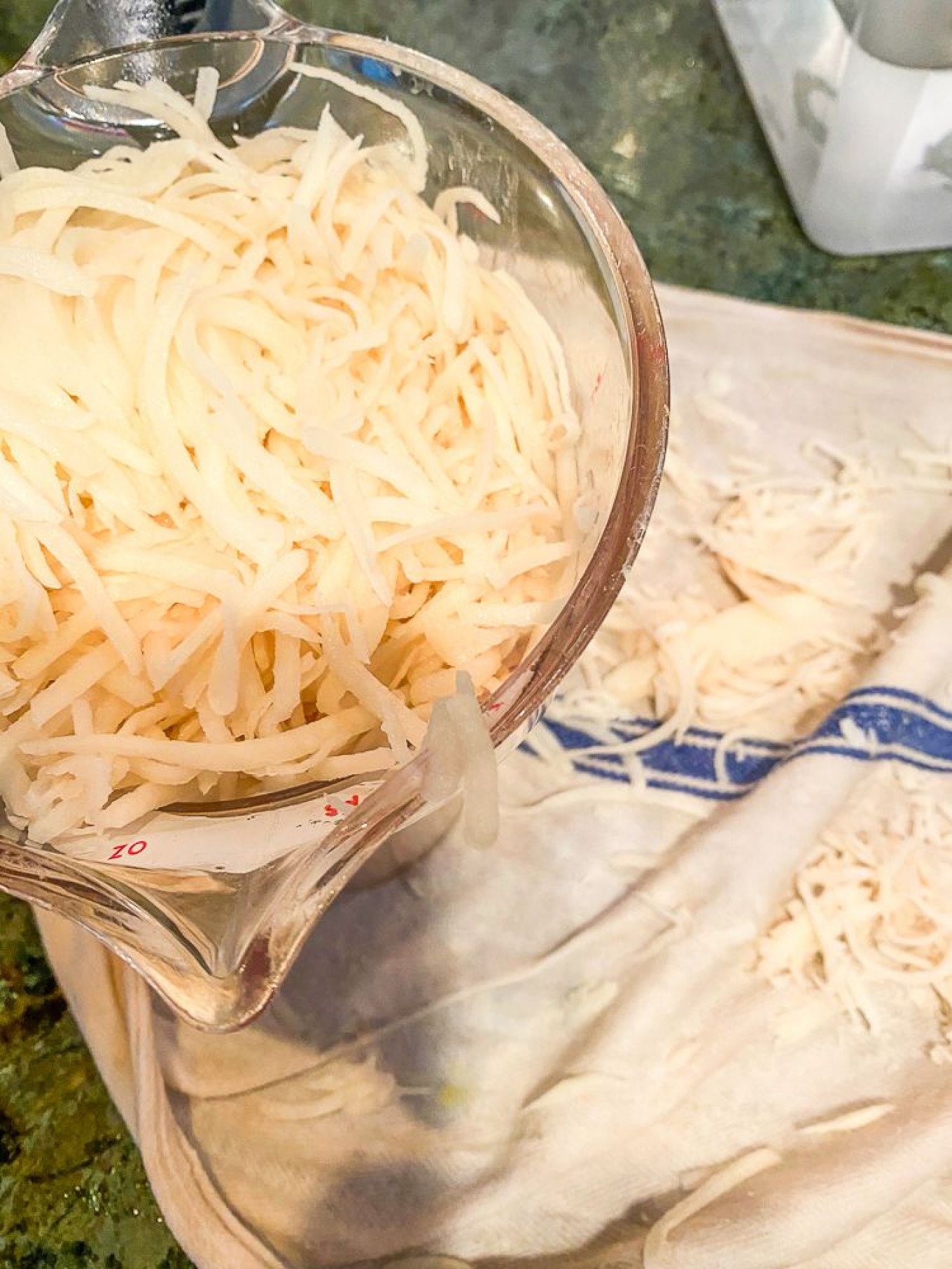
Instructions
- Peel the potatoes, then grate them in a food processor or on the coarse side of a box grater. Wrap the shredded potatoes in a cloth towel and squeeze out as much liquid as you can — do this several times until the potatoes are very dry. Set potatoes aside.
- In the bowl of a food processor fitted with a steel blade, process the onion until it is mushy and leaching liquid. Add the flour, egg, kefir, horseradish, salt, caraway seeds, red pepper and half of the chives and pulse to combine (6-7 times) until smooth.
- Place the flour and egg mixture in a large bowl, then gently fold in the grated potatoes, using your hands to toss until the mixture is combined.
- Preheat the oven to 200ºF (95ºC) and line a baking sheet with paper towel.
- Heat 1½ centimeters of oil over medium heat in a heavy-bottomed skillet (cast iron is best). The oil needs to be quite hot, so take the precaution of wearing sturdy oven mitts to avoid inevitable splattering.
- When the oil is sizzling (test by dropping one piece of potato in; if it browns easily, you’re all set), scoop ¼ cup (60 ml) of batter into the skillet, then use the back of a spatula to flatten the batter into a patty. Fry for about 3 minutes, until the pan side is golden brown. Use a wide spatula to flip the pancakes over and fry for an additional 2-3 minutes until that side is golden brown.
- As the pancakes cook, they will absorb the oil in the pan. Keep your oil handy to add more when the pan becomes dry. When the pancakes are done, place them on your prepared baking sheet and keep them warm in the oven until serving. They are best hot, right out of the skillet, but will crisp up well enough in the oven on the following day! Garnish with the remaining chives and serve with sour cream and yogurt spiked with fresh herbs and more red pepper.
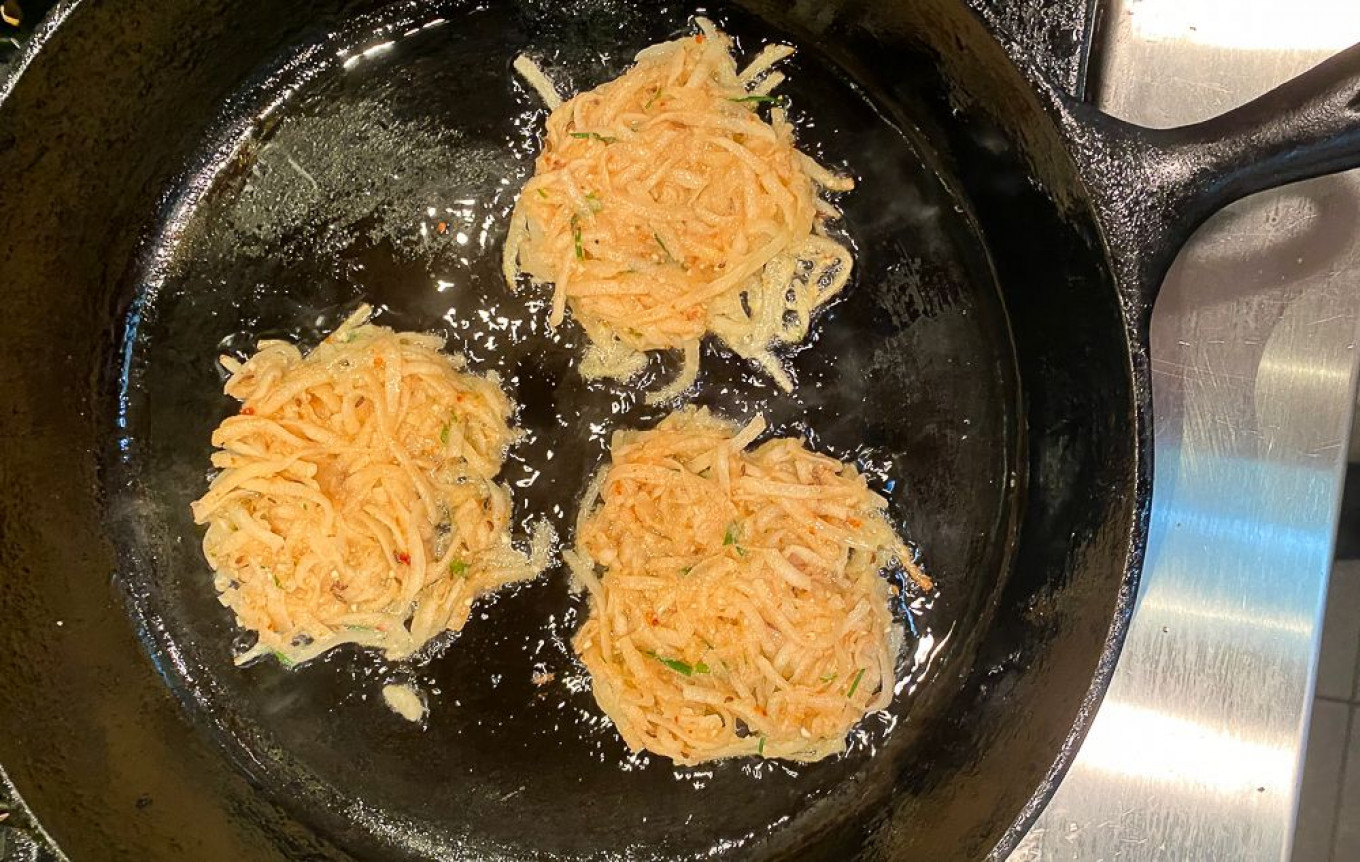
Adaptations
This is a base recipe which you can adapt with all kinds of additions. Below are some of my favorites, (including some of Belarus’ incomparable seafood)!
Add cheese: after you drop the pancake in the skillet, top it with a tablespoon of grated cheese, then add a layer of batter on top. Feta and Brinza work well here, as will a sharp cheddar or goat cheese.
Add herbs: a potato pancake is a wonderful culinary foil for the vibrant flavors of fresh herbs. Sage, thyme, and dill are classic pairing, but parsley, lovage, and basil work well too. Toss the freshly chopped herbs into the final batter, reserving a few spoonfuls to garnish.
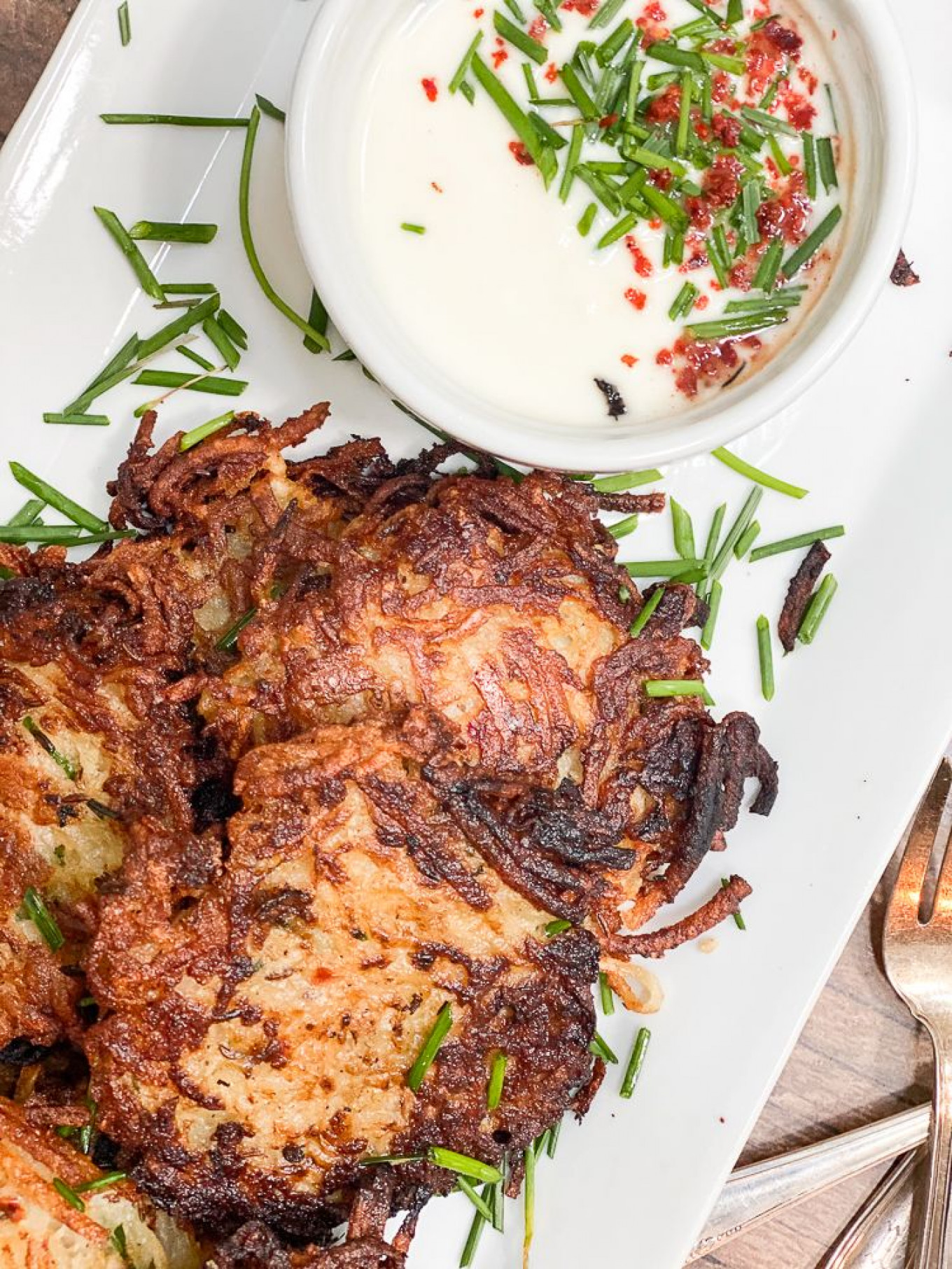
Add sausage: many Belarusians add meat to their draniki, which makes for a very filling main dish. Sausage meat injects flavor into the mix. Form raw sausage meat into thin patties that are about a centimeter smaller than the draniki. Drop the first batter into the skillet, then wait for 1-2 minutes. Add the sausage patty, then top with more batter. Cook for an additional 2 minutes, flip, then cook for 3 minutes on the other side, or until golden brown.
Add ham: shave cooked ham very thinly and toss with the batter.
Serve with smoked fish: top draniki with flaked smoked fish and a dollop of sour cream.
Put an egg on it: draniki will only improve with a poached or fried egg on top.
Waffle it: use a well-oiled waffle iron to “waffle” scoops of draniki batter for an extra crispy and crunchy version of the classic.
A Message from The Moscow Times:
Dear readers,
We are facing unprecedented challenges. Russia's Prosecutor General's Office has designated The Moscow Times as an "undesirable" organization, criminalizing our work and putting our staff at risk of prosecution. This follows our earlier unjust labeling as a "foreign agent."
These actions are direct attempts to silence independent journalism in Russia. The authorities claim our work "discredits the decisions of the Russian leadership." We see things differently: we strive to provide accurate, unbiased reporting on Russia.
We, the journalists of The Moscow Times, refuse to be silenced. But to continue our work, we need your help.
Your support, no matter how small, makes a world of difference. If you can, please support us monthly starting from just $2. It's quick to set up, and every contribution makes a significant impact.
By supporting The Moscow Times, you're defending open, independent journalism in the face of repression. Thank you for standing with us.
Remind me later.



